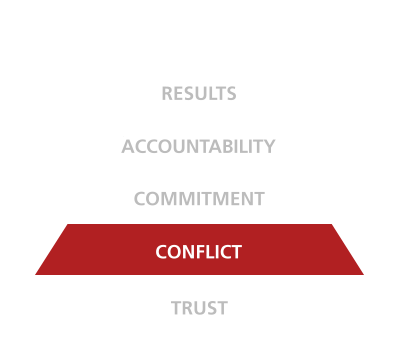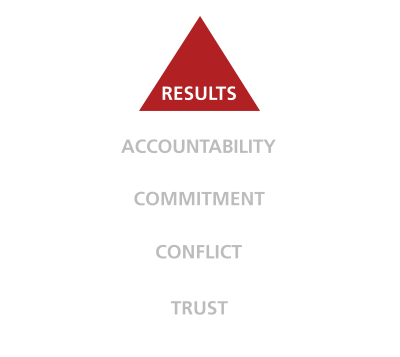Five Behaviours pour plus de performance d’équipe
Five behaviours : Cinq comportements. Le modèle aide les membres de l’équipe à travailler ensemble plus efficacement et à renforcer leur cohésion.
Une équipe productive et performante :
- Prend plus rapidement de meilleures décisions
- Exploite les compétences et les opinions de chacun
- Perd moins de temps (politique, confusion désaccords)
- Crée un avantage concurrentiel
- Évite les mauvais sujets en raison d’un manque d’adhésion
- Il est préférable en matière d’appartenance
La vidéo est en anglais mais le matériel de facilitation et le test sont bien disponibles en français.
Évaluation des performances en équipe et outils personnalisés
Five Behaviours ™ est une expérience d’apprentissage unique. Il aide les individus à découvrir ce qu’il faut pour atteindre l’avantage concurrentiel ultime du travail d’équipe. L’auteur Patrick Lencioni et nos principaux outils d’évaluation en milieu de travail sont réunis dans un programme éprouvé pour produire des résultats économiques.
EVALUATION
Évaluation comportementale validée par la recherche
Des résultats précis et personnalisés
LE PROFIL
Un contenu personnalisé
Des informations claires et accessibles
L’ATELIER
Engage et responsabilise jusqu’à 30 participants (personnel) ou 12 participants (équipe)
Interactif, pratique
OUTILS DE SUIVI
Rapport de comparaison
Rapport de suivi
Transformer un groupe d’individus en une équipe performante
Deux versions du programme sont disponibles : Personnelle – conçue spécifiquement pour les participants qui n’ont pas besoin de faire partie de la même équipe. Équipe – ce programme se concentre sur la mise en pratique du modèle des Five Behaviours (cinq comportements) dans un environnement d’équipe intégrée.
INDIVIDUEL
Individuels, ne faisant pas partie de la même équipe
✓ L’individu comprend le rôle de chacun dans l’équipe
✓ Créer une culture du travail d’équipe
✓ Conçu pour tout le monde
✓ Jusqu’à 30 participants
EQUIPE
Équipe, conjointement responsable des résultats
✓ Aperçu de soi, de l’équipe, du travail d’équipe
✓ Construire la cohésion
✓ Créé pour les équipes intactes
✓ 5 à 12 participants
LE MODELE FIVE BEHAVIOURS™
Deux versions du programme sont disponibles : Personnelle – conçue spécifiquement pour les participants qui n’ont pas besoin de faire partie de la même équipe. Équipe – ce programme se concentre sur la mise en pratique du modèle des cinq comportements dans un environnement d’équipe intégrée.
CONSTRUIRE LES BASES D’UNE ÉQUIPE SOUDÉE
Lorsque les membres d’une équipe sont vraiment transparents et honnêtes les uns envers les autres, ils créent un environnement
sûr qui crée et renforce la confiance basée sur la vulnérabilité. La confiance est au cœur du fonctionnement d’une équipe cohésive
et ne peut exister que si les membres de l’équipe sont prêts à être vulnérables les uns envers les autres.
Une évaluation de la personnalité peut aider les gens à mieux comprendre leurs pairs. Elle permet également
de développer l’empathie. Ces deux qualités permettent à une équipe d’établir la confiance.
S’ENGAGER DANS UN CONFLIT SAIN
Avec la confiance, les membres de l’équipe peuvent s’engager dans un débat d’idées non filtré et constructif.
Les conflits sont naturellement désagréables, mais les conflits productifs se concentrent sur les concepts et les idées et
sont essentiels à la croissance de toute grande équipe.
Lorsque les équipes ont une base de confiance fondée sur la vulnérabilité, le conflit devient simplement une
tentative de trouver rapidement une solution, le conflit devient simplement une tentative de trouver
rapidement la meilleure solution possible.
L’ADHÉSION AUX DÉCISIONS
L’engagement de l’équipe concerne la clarté des décisions, et non le consensus.
Avec l’engagement, les équipes vont de l’avant avec l’adhésion totale de tous les membres de l’équipe, y compris
ceux qui ne sont pas d’accord au départ.
Lorsque les membres de l’équipe peuvent exprimer leurs opinions et débattre d’idées, ils se sentent entendus et
respectés et seront plus enclins à s’engager dans les décisions.
RESPONSABILISER LES MEMBRES DE L’ÉQUIPE
Une fois que tout le monde s’est engagé à suivre un plan d’action clair, ils seront plus enclins à se responsabiliser les uns les autres.
Il est facile d’éviter les conversations difficiles, mais il est essentiel pour la productivité d’attirer l’attention de ses pairs sur
des performances ou des comportements susceptibles de nuire à l’équipe.
En entrant dans la zone de danger les uns avec les autres, les membres de l’équipe se sentent en confiance,
respectés et responsabilisés.
|
SE CONCENTRER SUR LES RÉSULTATS COLLECTIFS L’objectif final est d’obtenir des résultats en mettant en œuvre les principes du modèle, à savoir la confiance, le conflit, l’engagement et la responsabilité. L’un des principaux obstacles à la réussite d’une équipe est l’inattention portée aux résultats. Les meilleures équipes veillent à ce que tous les membres, indépendamment de leurs responsabilités individuelles et de leurs domaines d’expertise, fassent de leur mieux pour contribuer à la réalisation des objectifs de l’équipe. |
|
|
|
|
|
|
|
|
|
|
SE CONCENTRER SUR LES RÉSULTATS COLLECTIFS
L’objectif final est d’obtenir des résultats en mettant en œuvre les principes du modèle, à savoir la confiance, le conflit, l’engagement et la responsabilité. L’un des principaux obstacles à la réussite d’une équipe est l’inattention portée aux résultats.
Les meilleures équipes veillent à ce que tous les membres, indépendamment de leurs responsabilités individuelles et de leurs domaines d’expertise, fassent de leur mieux pour contribuer à la réalisation des objectifs de l’équipe.
UNE ÉQUIPE SOUDÉE TRAVAILLE MIEUX ENSEMBLE
Microsoft : Team Building et dynamique de groupe
Quarante employés exceptionnels, six mois à peine et la responsabilité d’une entreprise renommée du Fortune 100 : voilà ce que Darci Kleindl a reçu lorsqu’elle a accepté le poste de directrice générale de l’excellence des ventes et de la stimulation des ventes pour le groupe Microsoft Business Solutions (MBS).
Découvrez comment elle a prévu de mettre en œuvre un programme complet de développement du leadership et de l’équipe qui transformerait sa culture de travail et fournirait une structure de base à son équipe (en anglais).
COMMENT POUVONS-NOUS VOUS AIDER ?
COMMENT POUVONS-NOUS VOUS AIDER ?
FOIRE AUX QUESTIONS
Outils DiSC : pour un meilleur management
Souhaitez-vous instaurer de bonnes relations professionnelles ? Mieux communiquer et mieux comprendre le comportement de vos prospects pour mieux vendre ? La méthode DISC constitue la solution à toutes ces problématiques. Cet outil de communication plus efficace apporte de la fluidité à la communication et aux relations interpersonnelles. Découvrez dans le présent article ce qu’est le modèle DISC ? Quelles sont les typologies de profil DISC ? Et pourquoi utiliser l’outil DISC dans le management ?
Qu'est-ce que le modèle DiSC ?
- Dominance (rouge) ;
- Influence (jaune) ;
- Stabilité (vert) ;
- Conformité (bleu).
Pour déterminer le comportement principal d’un individu, Marston a utilisé deux axes. Le premier exprime sa vision de la situation dans un environnement (favorable ou hostile), tandis que le deuxième sur sa propension à agir dans cet environnement (acceptant ou agissant). Cette connaissance de soi vous aide à bien communiquer et à comprendre vos faiblesses.
Sachez que le modèle DISC facilite aussi l’identification des dominantes psychologiques des individus dans un environnement de travail. En tant que manager grâce à l’outil DISC, vous serez en mesure d’adopter un management adéquat si vous parvenez à percevoir le trait dominant de chacun de vos collaborateurs.
Quelles sont les typologies de profils DiSC ?
Issu de l’axe vertical et horizontal, William Marston a déterminé quatre catégories de réactions comportementales avec l’outil DISC. Il a attribué quatre couleurs aux quatre typologies afin de faciliter l’utilisation et la compréhension.
Le profil Disc dominant
Fonceur, puissant, déterminé, tenace, affirmé et souvent visionnaire, le profil dominant recèle d’un potentiel extraordinaire. Ce profil à tendance extravertie ne cherche pas à tourner autour du pot. Il est direct dans son mode de communication (verbale, gestuelle ou non verbale) et n’hésite pas à prendre la parole.
Elle peut paraître autoritaire et agressive avec son entourage, un potentiel danger pour la cohésion d’équipe. Par contre, cette personne a un esprit de compétition, ce qui lui permet de se concentrer sur ses objectifs. Elle s’appuie sur les faits pour agir et avancer. Les chefs d’entreprise et les grands intellectuels partagent ce type de personnalité.
Le profil Disc Influent
La personne ayant le profil Disc influent est de nature sociale, amicale, optimiste, très démonstrative et enthousiaste. Celle-ci entretient un très bon relationnel, ce qui lui permet d’être une personnalité appréciée au sein de l’équipe. Grâce à sa personnalité, elle aime les collaborations et fonctionne selon un mode démocratique.
Néanmoins, cette personne est parfois superficielle dans sa façon de trouver des problématiques et de gérer les dossiers. Son objectif est de susciter l’enthousiasme, de chercher à convaincre, de rechercher la reconnaissance et la collaboration.
Le profil Disc Stable
La personne ayant le profil Disc Stable est de nature calme, patiente, méthodique, loyale, sérieuse, fiable et humble. Ce profil de personnalité, à tendance introvertie et souple, est plutôt résistant au changement. Il est capable d’écouter son interlocuteur et ne s’impose jamais. Il sollicite le travail d’équipe. Son objectif est ainsi de prioriser le soutien et la collaboratio et de rechercher l’équilibre.
Le profil Disc Consciencieux
La personne ayant le profil Disc Consciencieux est de nature discrète, précise, factuelle, autonome, méthodique, organisée, structurée et analytique.
Souvent perçu comme froid et autoritaire, ce genre de profil est à l’aise dans les métiers comptables ou administratifs. Sachez que la personne à tendance introvertie, rigide, et centrée sur les tâches aime l’ordre et suivre les règles. Son objectif est de prioriser la précision, l’équilibre (suivi et modération) et les défis.
Pourquoi utiliser le modèle DISC dans le management ?
- Mieux connaître les autres pour communiquer efficacement ;
- Comprendre les autres et d’adapter à la personnalité ;
- Adopter une écoute empathique et de gérer les situations difficiles ;
- Encourager la communication ;
- Vendre et manager en couleur ;
- Améliorer le savoir-être pour établir des relations positives ;
- Établir un esprit d’équipe
Dans le processus de recrutement, le DISC permet au recruteur de mieux se connaître et comprendre le propre comportement du candidat en cas de stress par exemple. Ainsi, cette clé de communication vous aide aussi à identifier ses motivations, ses faiblesses, ses points forts, ses capacités relationnelles et ses aptitudes.
Dans le process communication management, il permet d’adapter la communication pour mieux se comprendre et mieux coopérer grâce à l’empathie suscitée. Enfin, l’outil DISC vous permet d’adapter à des interlocuteurs et d’anticiper son processus de décision, dans l’approche commerciale.

